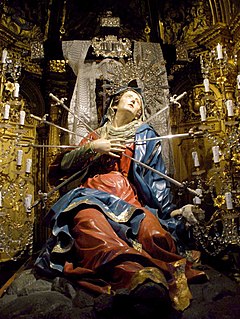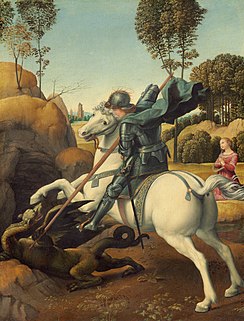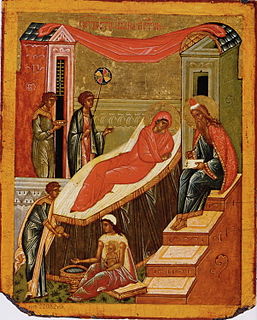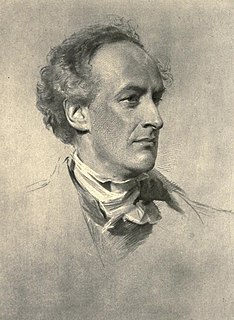
The liturgical year, also known as the church year or Christian year, as well as the kalendar, consists of the cycle of liturgical seasons in Christian churches that determines when feast days, including celebrations of saints, are to be observed, and which portions of Scripture are to be read either in an annual cycle or in a cycle of several years.

The calendar of saints is a traditional Christian method of organizing a liturgical year by associating each day with one or more saints and referring to the day as the feast day or feast of said saint. The word "feast" in this context does not mean "a large meal, typically a celebratory one", but instead "an annual religious celebration, a day dedicated to a particular saint".

Our Lady of Sorrows, Our Lady of Dolours, the Sorrowful Mother or Mother of Sorrows, and Our Lady of Piety, Our Lady of the Seven Sorrows or Our Lady of the Seven Dolours are names by which the Virgin Mary is referred to in relation to sorrows in her life. As Mater Dolorosa, it is also a key subject for Marian art in the Catholic Church.

Richard of Chichester, also known as Richard de Wych, is a saint who was Bishop of Chichester.

Saint George's Day, also known as the Feast of Saint George, is the feast day of Saint George as celebrated by various Christian Churches and by the several nations, kingdoms, countries, and cities of which Saint George is the patron saint including England, and regions of Portugal and Spain.

The Eastern Orthodox Liturgical Calendar describes and dictates the rhythm of the life of the Eastern Orthodox Church. Passages of Holy Scripture, saints and events for commemoration are associated with each date, as are many times special rules for fasting or feasting that correspond to the day of the week or time of year in relationship to the major feast days.

The Intercession of the Theotokos, or the Protection of Our Most Holy Lady Theotokos and Ever-Virgin Mary, is a feast of the Mother of God celebrated in the Eastern Orthodox and Byzantine Catholic Churches. The feast celebrates the protection afforded the faithful through the intercessions of the Theotokos. In the Slavic Orthodox Churches it is celebrated as the most important solemnity besides the Twelve Great Feasts and Pascha. The feast is commemorated in Eastern Orthodoxy as a whole, but by no means as fervently as it is in Russia, Belarus and Ukraine. It is not a part of the ritual traditions of, and therefore is not celebrated by, the Oriental Orthodox Churches or Western Rite Orthodoxy. Yet the feast is perfectly consistent with the theology of these sister churches. It is celebrated on October 14.

Marian devotions are external pious practices directed to the person of Mary, mother of Jesus, by members of certain Christian traditions. They are performed in Roman Catholicism and Orthodox Christianity, but generally rejected in Protestant denominations.

December 31 - Eastern Orthodox liturgical calendar - January 2
This article lists the feast days of the General Roman Calendar as they were at the end of 1954. It is essentially the same calendar established by Pope Pius X (1903–1914) following his liturgical reforms, but it also incorporates changes that were made by Pope Pius XI (1922–1939), such as the institution of the Feast of Christ the King, and the changes made by Pope Pius XII (1939–1958) prior to 1955, chief among them the imposition of the Feast of the Immaculate Heart of Mary upon the universal Church in 1944, the inscription of Pius X into the General Calendar following his 1954 canonization, and the institution of the Feast of the Queenship of Mary in October 1954.
The General Roman Calendar is the liturgical calendar that indicates the dates of celebrations of saints and mysteries of the Lord in the Roman Rite, wherever this liturgical rite is in use. These celebrations are a fixed annual date; or occur on a particular day of the week ; or relate to the date of Easter. National and diocesan liturgical calendars, including that of the diocese of Rome itself as well as the calendars of religious institutes and even of continents, add other saints and mysteries or transfer the celebration of a particular saint or mystery from the date assigned in the General Calendar to another date.

Christ Church Cathedral is the cathedral of the diocese of Oxford, which consists of the counties of Oxfordshire, Buckinghamshire and Berkshire. It is also the chapel of Christ Church at the University of Oxford. This dual role as cathedral and college chapel is unique in the Church of England.

The Nativity of John the Baptist is a Christian feast day celebrating the birth of John the Baptist.

Anglican Marian theology is the summation of the doctrines and beliefs of Anglicanism concerning Mary, mother of Jesus. As Anglicans believe that Jesus was both human and God the Son, the second Person of the Trinity, within the Anglican Communion and Continuing Anglican movement, Mary is accorded honour as the theotokos, a Koiné Greek term that means "God-bearer" or "one who gives birth to God".

The priory of St Frideswide, Oxford, was established as a priory of Augustinian canons regular, in 1122.
This article lists the feast days of the General Roman Calendar as reformed on 25 July 1960 by Pope John XXIII's motu proprioRubricarum instructum. This 1960 calendar was incorporated into the 1962 edition of the Roman Missal, continued use of which Pope Benedict XVI authorized in his 7 July 2007 motu proprio Summorum Pontificum as an "extraordinary form of the Roman Rite".

The Bogolubovo Icon is a Wonderworking Icon of the Theotokos Agiosoritissa which is venerated in the Russian Orthodox Church. The icon was painted in the 1157 at the request of Grand Prince Andrew Bogolubsky, in commemoration of an appearance to him by the Mother of God.
Marian feast days are specific holy days of the liturgical year recognized by Christians as significant Marian days for the celebration of events in the life of the Blessed Virgin Mary and her veneration. The number of Marian feasts celebrated, their names can vary among Christian denominations.

The Personal Ordinariate of Our Lady of Walsingham in England and Wales is a personal ordinariate of the Roman Catholic Church immediately subject to the Holy See within the territory of the Catholic Bishops' Conference of England and Wales, of which its ordinary is a member, and encompassing Scotland also. It was established on 15 January 2011 for groups of former Anglicans in England and Wales in accordance with the apostolic constitution Anglicanorum coetibus of Pope Benedict XVI.



















